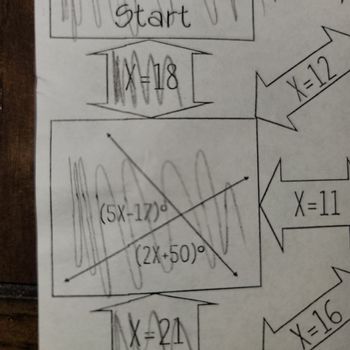
Elementary Geometry For College Students, 7e
7th Edition
ISBN: 9781337614085
Author: Alexander, Daniel C.; Koeberlein, Geralyn M.
Publisher: Cengage,
expand_more
expand_more
format_list_bulleted
Question
Solve for x.

Transcribed Image Text:The image is a flowchart or diagram intended to guide the viewer through a mathematical problem involving angles and algebraic expressions. Here's a text transcription and description:
1. **Start** - This is the initial point of the flowchart.
2. **X = 18** - Represents a potential solution for the variable X.
3. A box features two linear expressions inside a rectangle oriented diagonally, likely depicting angles:
- **(5X - 17)°**
- **(2X + 50)°**
- These expressions suggest a geometry problem where the equations describe angles, possibly part of a larger problem involving solving for X using angle properties.
4. **X = 21** - Another potential solution for X, suggesting the viewer to verify different values.
5. **X = 12** - An additional branch with a possible value for X.
6. **X = 11** - Another branch featuring a different value.
7. **X = 16** - Yet another possible value.
### Explanation of the Diagram
The diagram uses a flow from one expression to another, likely instructing the user to test different values of X in the algebraic angle equations to find a valid solution. The use of diagonal lines resembling intersecting lines or angles reinforces the geometric context.
This diagram is typically used in educational settings to help students understand how to manipulate algebraic expressions while applying geometric principles, such as the sum of angles.
Expert Solution
This question has been solved!
Explore an expertly crafted, step-by-step solution for a thorough understanding of key concepts.
This is a popular solution
Trending nowThis is a popular solution!
Step by stepSolved in 2 steps with 2 images

Knowledge Booster
Similar questions
arrow_back_ios
SEE MORE QUESTIONS
arrow_forward_ios
Recommended textbooks for you
 Elementary Geometry For College Students, 7eGeometryISBN:9781337614085Author:Alexander, Daniel C.; Koeberlein, Geralyn M.Publisher:Cengage,
Elementary Geometry For College Students, 7eGeometryISBN:9781337614085Author:Alexander, Daniel C.; Koeberlein, Geralyn M.Publisher:Cengage, Elementary Geometry for College StudentsGeometryISBN:9781285195698Author:Daniel C. Alexander, Geralyn M. KoeberleinPublisher:Cengage Learning
Elementary Geometry for College StudentsGeometryISBN:9781285195698Author:Daniel C. Alexander, Geralyn M. KoeberleinPublisher:Cengage Learning

Elementary Geometry For College Students, 7e
Geometry
ISBN:9781337614085
Author:Alexander, Daniel C.; Koeberlein, Geralyn M.
Publisher:Cengage,

Elementary Geometry for College Students
Geometry
ISBN:9781285195698
Author:Daniel C. Alexander, Geralyn M. Koeberlein
Publisher:Cengage Learning